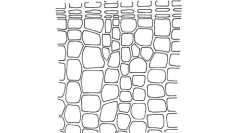

 Geodiversitas
33 (1) - Pages 25-32
Geodiversitas
33 (1) - Pages 25-32The Mesozoic strata of Muang Phalan in southern Laos yielded fossils of terrestrial organisms (vertebrates, molluscs, wood). The latter was assigned to a species known from the Liassic strata of Denmark, Brachyoxylon rotnaense Mathiesen, whereas vertebrates are indicative of a late Early Cretaceous age. A revision of the type material for B. rotnaense and for its putative taxonomical synonym Simplicioxylon hungaricum Andreánszky, of the Lao material and of new material from Thailand allowed to: 1) confirm the taxonomical synonymy; 2) reject the assignment of the Lao material to the European species; and finally 3) to recognize a new species, here described as B. serrae n. sp., encompassing the Lao and Thai materials. This new species of Brachyoxylon is characterized by the occurrence, in the radial pitting, of clusters of much flattened contiguous pits and of pairs of opposite pits in otherwise long araucarian uniseriate rows. Our revision removed the stratigraphical ambiguity and confirmed the biogeographical peculiarity of Indosinian terrestrial biomes during the Early Cretaceous.
Fossil wood, Brachyoxylon, Cretaceous, Laos, Thailand, new species.